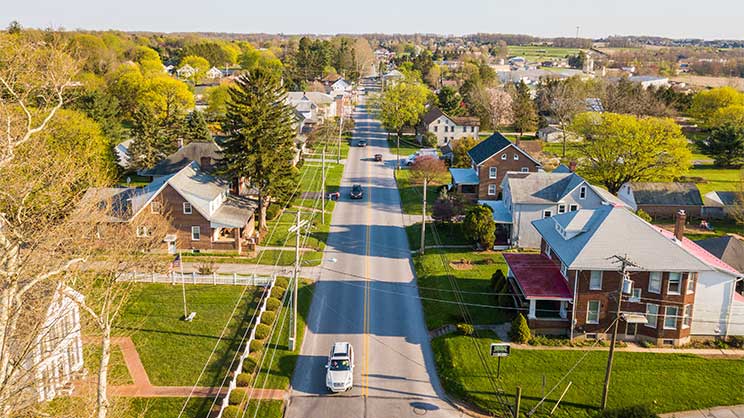Drug Use In Rural Areas | Why Is Drug Use Higher In Rural Areas?

Medically Reviewed By: Kimberly Langdon, M.D.
Many residents in rural America struggle with drugs and alcohol. They also face unique challenges when it comes to addiction treatment. In response to these challenges, many individuals are advocating for more inpatient and outpatient treatment options in rural areas.

About 1 in 5 Americans live in rural areas. A rural area is a community with relatively few people and buildings.
Most substance abuse reports focus on highly populated urban areas. However, many rural residents struggle with drugs as well. They also face unique challenges when it comes to addiction treatment.
Substance Use In Rural Areas
Compared to other Americans, people in rural counties are more likely to experience certain stressors, such as unemployment, poverty, isolation, and reduced access to behavioral health services.
To cope with these issues, some people turn to substance abuse, including illicit drug use, prescription drug abuse, and alcohol abuse.
All forms of substance abuse can lead to drug addiction (substance use disorder). This disease makes you feel unable to stop using drugs.
Both substance abuse and addiction contribute to issues such as:
- crime
- poor academic performance
- drunk driving accidents
- increased rates of infectious diseases like HIV due to people sharing needles, syringes, and other drug paraphernalia
- homelessness
- increased overdose deaths and suicides
Which Drugs Are Most Popular In Rural America?
People in rural communities have higher rates of both methamphetamine and tobacco use.
Methamphetamine
Methamphetamine (or “meth”) is an extremely powerful stimulant drug. It has been linked to numerous health problems, including addiction, heart attack, and stroke.
The drug can also make you feel panicked, irritable, and even aggressive. That’s why some people who use meth are more likely to commit violent crimes.
Tobacco
Tobacco is a plant that contains a highly addictive substance called nicotine. It’s typically smoked in a cigarette or cigar.
According to the 2020 National Survey on Drug Use and Health, 38.6% of young adults in rural populations use tobacco, compared to only 26.9% of young adults in urban areas.
The Centers for Disease Control and Prevention (CDC) has linked tobacco use with health problems such as:
- cancer
- chronic obstructive pulmonary disease (COPD)
- diabetes
- heart disease
- lung disease
- stroke
How Has The Opioid Crisis Affected Rural America?
In general, people in smaller communities have similar opioid use rates as people in urban communities.
However, rural residents tend to experience more opioid overdose deaths. This disparity might be related to the fact that rural communities usually have less access to naloxone. Naloxone (brand name Narcan) is a medication that can quickly reverse the effects of an opioid overdose.
Also, while many urban residents abuse prescription opioids they get from their doctors, rural residents may be more likely to buy opioids on the street, including heroin.
Many street drugs are secretly laced with fentanyl. Fentanyl is an extremely potent opioid that has caused numerous drug overdose deaths throughout the opioid epidemic.
The higher prevalence of opioid overdose deaths in rural America may also reflect the fact that many rural health care providers have less experience treating opioid overdoses compared to big city doctors.
Treatment & Prevention
Rural Americans are less likely to receive substance abuse and addiction treatment than other Americans. In many cases, this is because smaller communities tend to hold more stigma toward addiction. They may view it not as a disease but as a personal failure.
Some people try to avoid this stigma by denying that they need treatment, especially since most small towns feature little privacy and large amounts of gossip.
Improve Access To Treatment
In addition, even when rural residents want to get treatment, they often have trouble accessing it, as many of them do not have health insurance.
Also, many rural areas lack treatment centers. That means residents must travel for treatment, which can take a significant amount of time and money.
Develop More Rehab Centers
In response to these shortages, many individuals are advocating for more inpatient and outpatient treatment facilities to be built in rural areas.
These facilities should offer a wide variety of evidence-based treatment services. According to the Substance Abuse and Mental Health Services Administration (SAMHSA), the most popular evidence-based treatments include:
- medical detox, in which doctors help you stop using drugs with minimal withdrawal symptoms
- medication-assisted treatment, in which doctors use medications like acamprosate, buprenorphine, and naltrexone to treat opioid and alcohol use disorders
- behavioral therapy, in which a therapist helps you change unhealthy beliefs and behaviors that contribute to your drug abuse
- family therapy, in which a therapist helps you and your family members resolve conflicts and support your long-term recovery
Community-Based Programs
Along with advocating for more professional treatment options, rural residents can also create community-based programs that aim to prevent substance abuse.
These initiatives educate community members on the dangers of drugs and how to seek treatment. They can be especially helpful when focused on adolescents, many of whom experiment with drugs due to curiosity, peer pressure, or mental health concerns.
If you or someone you love struggles with drugs, please contact Ohio Recovery Center. Our inpatient substance abuse treatment programs offer personalized, comprehensive care to help you stay sober and healthy.
- Centers for Disease Control and Prevention - Health Effects https://www.cdc.gov/tobacco/basic_information/health_effects/index.htm
- Substance Abuse and Mental Health Services Administration - 2020 NSDUH Detailed Tables https://www.samhsa.gov/data/report/2020-nsduh-detailed-tables
- United States Census Bureau - One in Five Americans Live in Rural Areas https://www.census.gov/library/stories/2017/08/rural-america.html
- University of North Dakota Center for Rural Health - The 2014 Update of the Rural-Urban Chartbook https://ruralhealth.und.edu/

